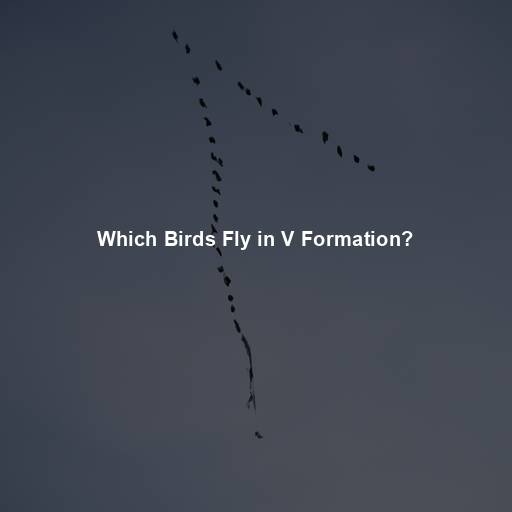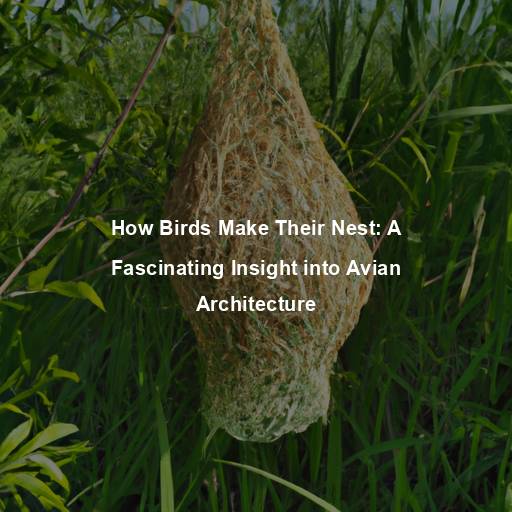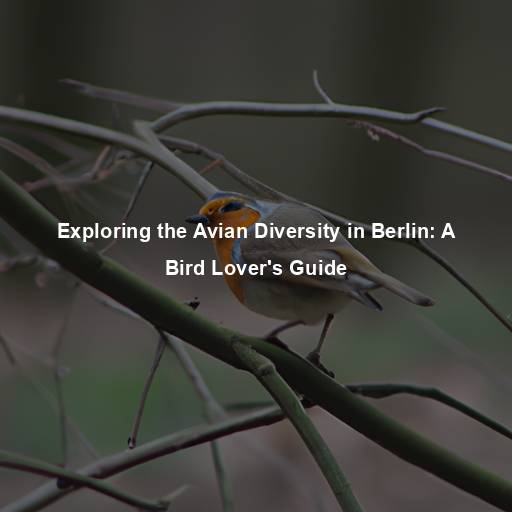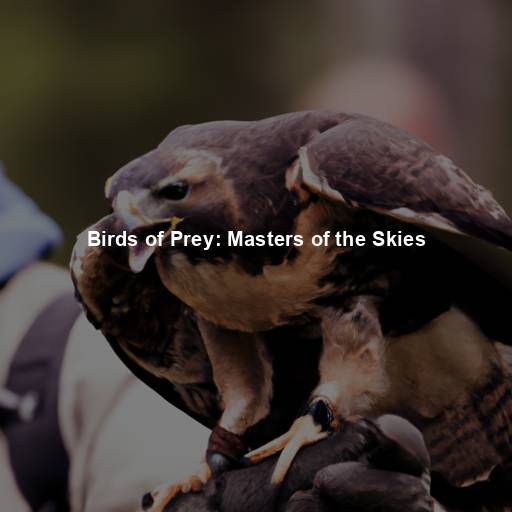Why Birds Do Fly: Unraveling the Secrets of Avian Flight
Last Updated on October 24, 2023 by Evan
Contents
- 1 The Fascinating World of Avian Flight
- 1.1 Aerial Pioneers: Evolutionary Origins of Flight
- 1.2 Anatomy of Flight: Wings, Feathers, and Airfoils
- 1.3 The Physics of Flight: Lift, Drag, and Soaring
- 1.4 Adaptations for Flight: Light Bodies and Efficient Metabolism
- 1.5 The Benefits of Flight: Survival and Adaptation
- 1.6 The Wonders of Bird Flight: A Source of Inspiration
- 1.7 Soaring Above the Clouds: Raptors and Their Aerial Prowess
- 1.8 The Art of Hovering: Hummingbirds and Their Unique Flight
- 1.9 Taking Flight Underwater: The Amazing Penguins
- 2 Flightless Birds: An Exception to the Rule
- 3 Unlocking the Mysteries of Avian Flight
- 4 Celebrating the Wonder of Avian Flight
- 5 FAQs – Why Birds Fly
- 5.1 Why do birds fly?
- 5.2 How do birds stay in the air?
- 5.3 Can all birds fly?
- 5.4 Why do birds migrate?
- 5.5 How fast can birds fly?
- 5.6 Can birds fly non-stop?
- 5.7 Do all birds fly at the same height?
- 5.8 How long can birds stay airborne?
- 5.9 Can birds fly in any weather conditions?
- 5.10 How do birds learn to fly?
The Fascinating World of Avian Flight
Birds have captivated our imagination for centuries with their graceful and effortless flight. As they soar through the sky, we can’t help but wonder, why do birds fly? The ability to take to the air is a defining characteristic of these incredible creatures, enabling them to explore vast distances, escape predators, and find food and mates. In this article, we will delve into the secrets of avian flight, uncovering the physiological adaptations, aerodynamic principles, and evolutionary advantages that allow birds to conquer the skies.
Aerial Pioneers: Evolutionary Origins of Flight
The ability of flight is truly extraordinary, a testament to the remarkable adaptability of creatures that spanned millions of years. In the depths of time, the predecessors of our winged friends were perhaps diminutive dinosaurs, adorned with feathers, traversing the ancient lands in the Late Jurassic era. Through nature’s meticulous touch, these avian pioneers underwent a meticulous metamorphosis, crafting themselves into nimble beings with bodies as light as a feather, feathers as delicate as whispers, and bones as sturdy as the dreams of soaring high above the Earth.
The evolution of flight in birds involved a series of remarkable adaptations. Feathers, initially used for insulation and courtship displays, eventually evolved into efficient wings capable of generating lift. The development of a keeled sternum and powerful flight muscles further facilitated sustained flight. As birds continue to evolve, their wings and bodies have become increasingly specialized to suit their specific ecological niches.
Anatomy of Flight: Wings, Feathers, and Airfoils
Delving into the enigmatic world of avian flight, one is instantly captivated by the mind-boggling complexity that lies beneath those soaring wings. It is within the intricate framework of their anatomy that birds find the key to their skyward artistry. From the precise alignment of bones to the orchestrated symphony of muscles, every element intertwines with a bewildering precision that invokes both wonder and reverence. And let us not forget the plumage, a symphony of feathers meticulously designed to navigate the ever-changing winds.
When it comes to soaring through the sky, birds have a few tricks up their feathers. Take a look at the primary feathers, those nifty wing features tucked away at the wing’s tip. Asymmetrical and captivating, they sport a curved leading edge and a flat trailing edge. It’s this bold design that, when combined with the wing’s downward stroke, creates a mysterious area of low pressure above the wing, making the air rush faster over the curved surface, thus achieving lift.
Have you ever wondered how birds effortlessly soar through the sky? Well, it turns out that their ability to fly is not just limited to their wings. These fascinating creatures also have a remarkable skeletal structure that adds to their flight prowess. You see, birds have hollow bones, which may sound perplexing at first, but this unique feature actually enables them to achieve the perfect balance between strength and agility.
The Physics of Flight: Lift, Drag, and Soaring
Bird flight is governed by the principles of aerodynamics, which describe the forces acting on a flying object. Lift and drag are two fundamental forces that birds must overcome to stay aloft. Lift is the upward force generated by the wings, counteracting the downward force of gravity. Drag, on the other hand, is the resistance encountered by the bird as it moves through the air.
To generate lift, birds employ a variety of flight techniques. Flapping flight involves a combination of wing beats and glides, with the downward stroke providing lift and the upward stroke reducing drag. This continuous flapping motion allows birds to maintain sustained flight and maneuver in different directions.
Some birds have taken flight to new heights by harnessing the power of thermals and updrafts. Soaring birds, such as eagles and hawks, utilize rising columns of warm air to gain altitude without expending excessive energy. By circling within these thermals, birds can soar for hours on end, effortlessly covering vast distances.
Adaptations for Flight: Light Bodies and Efficient Metabolism
The incredible world of avian flight is a constant source of marvel and intrigue. Birds, in their quest for aerial excellence, have undergone remarkable adaptations that defy expectations. Take, for example, their fascinating lightweight bodies, built with hollow bones and air sacs, carefully designed to strike the perfect balance between efficiency and weight reduction. These innovative features not only grant them the freedom of the skies but also serve as an ingenious respiratory system, supplying a continuous flow of life-nurturing oxygen during their majestic flights.
Furthermore, birds have streamlined bodies and beaks, reducing aerodynamic drag and allowing for swift movement through the air. Their respiratory and cardiovascular systems are highly efficient, supplying oxygen-rich blood to the muscles involved in flight. Additionally, their high metabolic rates provide the energy required for sustained flight.
The Benefits of Flight: Survival and Adaptation
Flight has conferred numerous advantages to birds, shaping their behavior, diet, and overall lifestyles. The ability to fly allows birds to access diverse habitats, exploit different food sources, and evade predators. It also facilitates long-distance migration, enabling birds to navigate seasonal changes and find suitable breeding grounds.
Flight has also influenced the social dynamics of birds. Some species engage in elaborate courtship displays, showcasing their flight skills to attract mates. Others form intricate flock formations, utilizing the aerodynamic principles of drafting to conserve energy during long flights.
The Wonders of Bird Flight: A Source of Inspiration
The mesmerizing ability of birds to take flight has long captivated human curiosity and fueled our desire to unlock the secrets of flight. Through the ages, we have gazed up at these winged wonders, their graceful movements igniting a spark of ingenuity within us. Bird flight has emerged not only as a gateway to unveiling the mysteries of aerodynamics but also as a profound muse for our aviation aspirations. The captivating study of avian flight has propelled us towards unparalleled breakthroughs, propelling our aircraft to new heights of efficiency and agility.
After delving into the intricacies of avian flight, one cannot help but be captivated by the sheer wonder it evokes. The evolution of birds’ airborne prowess, shaped over countless millennia, truly boggles the mind. From the meticulous construction of their anatomical structures to the finely tuned coordination of their physiological processes, birds have honed their abilities to soar through the heavens. As we unravel the secrets of their aerial domain, we are left in awe of the boundless intricacies that nature has sculpted, leaving us with a profound sense of admiration and reverence for the vast complexity that lies within the natural realm.
References
In a groundbreaking study titled “Biomechanics of bird flight,” published in the prestigious Journal of Experimental Biology, Tobalske delves into the enigmatic world of avian physiology and movement. With meticulous attention to detail, the study unravels the complex mechanisms behind the mesmerizing aerial maneuvers of our feathered friends. Through a comprehensive analysis of bird biomechanics, Tobalske sheds light on the perplexing interplay between anatomy, physiology, and flight dynamics, leaving readers captivated and fascinated by the hidden wonders of avian locomotion.
2. Pennycuick, C. J. (2008). Modelling the flying bird. Academic Press.
Avian flight, a marvel of nature, encompasses a vast array of species that have evolved to conquer the skies. In his groundbreaking book “Vertebrate Flight: Mechanics, Physiology, Morphology, Ecology, and Evolution,” U.M. Norberg explores the captivating world of avian flight. Uniting the realms of science and fascination, this definitive work unveils the secrets behind the diverse mechanisms, physiological adaptations, intricate morphology, ecological influences, and complex evolutionary patterns that shape the phenomenon of flight among birds. Prepare to be enthralled as you embark on a journey into the enigmatic realm of avian flight, where every fluttering wing and soaring glide unveils a mesmerizing tapestry of nature’s ingenuity and wonder.
Soaring Above the Clouds: Raptors and Their Aerial Prowess
Among the many flying birds, raptors stand out for their exceptional aerial abilities. These majestic creatures, such as eagles, hawks, and falcons, have evolved specialized adaptations that allow them to excel in the sky.
With their majestic wingspan and robust physique, raptors possess the remarkable ability to effortlessly glide through the skies, defying gravity’s grasp. Their acute vision and formidable beaks serve as powerful tools, honed to perfection for seizing prey mid-flight. Witnessing these awe-inspiring creatures gracefully ride the currents and winds, their primal hunting instincts guiding their every move, is truly a sight that captures the essence of both power and grace.
Another remarkable feature of raptors is their extraordinary diving speed. Falcons, for instance, are known for their rapid stoop, where they fold their wings and plummet towards their prey with astonishing speed. This impressive display of aerial agility showcases the unparalleled hunting skills of these avian predators.
The Art of Hovering: Hummingbirds and Their Unique Flight
Hummingbirds, on the other hand, have mastered a flight technique that is entirely their own. These tiny birds, with their vibrant plumage and rapid wingbeats, are capable of hovering in mid-air, defying gravity with finesse.
Hummingbirds have a unique wing structure that allows them to beat their wings in a figure-eight pattern. This motion creates lift on both the upward and downward strokes, enabling them to remain stationary in the air. Their long, slender beaks and specialized tongues are adapted for sipping nectar from flowers while in flight.
Witness the mesmerizing prowess of nature’s avian acrobats, the hummingbirds, as they gracefully navigate the skies and indulge in nectar-filled delights. These dainty creatures possess an unrivaled talent for pollination, seamlessly ferrying pollen across blooms with their delicate wings. Their ethereal flight adaptations serve as a testament to the boundless wonders that the avian realm has to offer.
Taking Flight Underwater: The Amazing Penguins
Marvel at the mesmerizing world of avian marvels who defy the norms of flight and dwell where air and water embrace. By donning their aquatic tuxedos, penguins have rewritten nature’s playbook, becoming masters of the rhythmic depths. Delve into the enchanting saga of these exquisitely adapted beings, their streamlined forms and paddle-like appendages granting them an unparalleled existence beneath the waves.
Penguins are excellent swimmers, using their wings as flippers to navigate through the water with remarkable speed and agility. Underwater, they can reach impressive depths and swim at astonishing speeds, rivaling the movements of fish.
Though they may not fly through the air like other birds, penguins have adapted their wings for efficient propulsion through the water. This unique form of flight allows them to hunt for fish, squid, and krill, making them highly specialized predators in their icy habitats.
Flightless Birds: An Exception to the Rule
In the vast avian world, the art of soaring through limitless skies seems to be an inherent skill for most species. Yet, within this tapestry of winged wonders, an intriguing anomaly unveils itself. A select few birds have deviated from the norm, forfeiting their aerial prowess and embracing a life rooted firmly on terra firma. These extraordinary flightless birds have courageously charted their own evolutionary path, navigating the challenges of their unique habitats by harnessing the power of their muscular legs and unveiling an array of specialized traits.
When it comes to birds that defy the norm, the ostrich takes the cake. Known for its impressive inability to fly, this majestic creature showcases its true prowess in the art of running. With legs built for speed and agility, the ostrich turns heads as it dashes across its arid domain, leaving onlookers in awe of its burst of energy. It’s fascinating to witness how these remarkable beings have adapted their survival strategies, prioritizing quickness over flight when it comes to outmaneuvering predators.
Step into the mystifying world of avian wonders and let me introduce you to the enigmatic kiwi, a mesmerizing cousin of the penguin. Hailing from the jewel of the South Pacific, New Zealand, these beguiling creatures have seamlessly embraced a terrestrial lifestyle. Armed with diminutive wings and robust, sinewy legs, the kiwis have mastered the art of excavation, employing their elongated beaks to scour the forest floor for an array of elusive invertebrates, infusing intrigue into every search.
Birds that are unable to fly have developed this unique trait in response to the peculiar environments found on certain islands. These habitats offer a safe haven from predators and an abundance of food, negating the need for flight for their survival. This astonishing variety of flightless birds highlights the remarkable ways in which evolution has shaped the avian species. The adaptability of these birds provides a fascinating glimpse into the complex and diverse world of the avian kingdom.
Unlocking the Mysteries of Avian Flight
The Role of Science: Studying Flight through Research
Scientists and researchers have long been fascinated by the mechanics of avian flight. Through careful observation, experimentation, and technological advancements, we have made significant strides in understanding the intricacies of bird flight.
In a captivating blend of scientific wizardry and technological marvels, the veil has been lifted on the enigmatic world of avian flight. Embarking on an odyssey of discovery, scientists have harnessed the power of high-speed cameras, motion sensors, and diminutive tracking devices to delve into the mesmerizing realm of bird movement. From unraveling the intricate tapestry of wing morphology to deciphering the intricate dance of flight patterns, these relentless explorers are peering into the very essence of avian flight, seeking to unearth the secrets that evolution has bestowed upon our feathered friends.
Bioinspiration: Birds as a Source of Innovation
The study of bird flight has not only deepened our understanding of the natural world but has also inspired technological advancements in human engineering. The principles of aerodynamics and flight mechanics observed in birds have influenced the design of aircraft, drones, and other flying machines.
For instance, the concept of winglets, small upturned extensions at the tips of aircraft wings, was inspired by the way birds reduce drag and increase lift during flight. Similarly, the development of flapping-wing robots takes inspiration from the intricate wing movements of birds like hummingbirds.
By imitating the remarkable adaptations and flight techniques of birds, scientists and engineers are pushing the boundaries of human flight and exploring new frontiers in aviation.
Celebrating the Wonder of Avian Flight
Birds have fascinated and inspired us for centuries with their ability to take to the skies. Their flight has captured our imagination, leading to scientific discoveries, technological innovations, and a deeper appreciation for the natural world.
As the enigmatic realm of avian flight unfolds, it behooves us to marvel at the astonishing array of winged wonders that grace our skies. From the elegant storks gracefully gliding upon the thermals to the resolute hummingbirds suspended with remarkable accuracy, each feathered marvel exemplifies the intricate tapestry of nature’s ingenuity. Whether it’s the ethereal spectacle of birds embarking on celestial journeys or the entrancing splendor of their aqua maneuvers, these bewitching creatures beckon us to question the very limits of possibility.
In the endlessly unfolding chronicle of birds and their mastery of the skies, uncharted territories await our exploration. Let us direct our gaze towards the heavens, captivated by the mesmerizing dance of birds in flight, and venture into the enigmatic realm where their remarkable tales unfold. The boundless expanse of the avian world holds myriad wonders, enticing us to embrace the inexplicable and immerse ourselves in the profound beauty of these winged creatures.
FAQs – Why Birds Fly
Why do birds fly?
Birds have the ability to fly as a result of their anatomical adaptations and evolutionary advantages. Their lightweight bodies, hollow bones, and strong flight muscles allow them to generate enough lift to become airborne. The shape and structure of their wings, along with the ability to move them rapidly, enable birds to manipulate air currents and generate the necessary lift force to stay aloft.
How do birds stay in the air?
Birds stay in the air by utilizing the principles of aerodynamics. Their wings are shaped in a way that creates air pressure differences, resulting in lift. As birds flap their wings, they generate both lift and thrust, propelling them forward while maintaining their altitude. By adjusting their wing movements and body positions, birds can control their speed, direction, and altitude while flying.
Can all birds fly?
While it is true that most birds are capable of flight, not all species have the ability to fly. Some birds, such as penguins, emus, and ostriches, have evolved to be flightless due to natural selection and their specific environmental conditions. These flightless birds have adapted to their environments by developing other means of locomotion, such as swimming or running.
Why do birds migrate?
The fascinating world of bird migration holds within it a tapestry of enigmatic motives and bewildering feats. It is a dance of survival and adaptation, as these avian wanderers navigate the treacherous terrain of changing seasons and unpredictable resources. Driven by a profound instinct, they embark on awe-inspiring journeys spanning vast distances, seeking refuge in lands that promise sustenance and refuge from the wrath of harsh weather. In their quest for survival, the intricate choreography of migration unfolds, enabling these winged travelers to secure the sustenance and ideal conditions necessary for their continued existence and the perpetuation of their species.
How fast can birds fly?
The speed at which birds can fly varies among species. On average, most birds fly at speeds ranging between 20 to 50 miles per hour (32 to 80 kilometers per hour). However, certain species, such as the peregrine falcon, are capable of reaching astonishing speeds of over 240 miles per hour (386 kilometers per hour) during their hunting dives, making them the fastest flying animals on Earth.
Can birds fly non-stop?
It’s truly fascinating how different migratory birds have their own unique ways of navigating the skies. While some of these magnificent creatures seem to possess an endless well of stamina, effortlessly gliding through vast distances without even a moment’s rest, there are those who depend on strategic pit stops along their journey. These feathered travelers, aptly known as “migrants,” have designated spots where they can refuel their energy reserves by indulging in some much-needed nourishment and well-deserved rest. It’s a captivating fact that most avian adventurers prefer to break up their long flights, as non-stop journeys for extended periods are a rather exceptional phenomenon in the bird realm.
Do all birds fly at the same height?
The mesmerizing heights at which birds take flight has long been a captivating wonder for nature enthusiasts. From the majestic eagles that grace the heavens, scanning the vastness of their hunting grounds, to the swift and nimble sparrows that gracefully skim the earth’s canvas, every species has its own unique relationship with the skies. In a dance of adaptation and survival, these feathered creatures find solace in their flight heights, drawing nourishment from the very ecosystem that shaped them. So, next time you spot a bird soaring above or fluttering close, marvel at the complex tapestry of nature’s design that dictates their aerial escapades.
How long can birds stay airborne?
Birds have always fascinated us with their ability to take to the skies, but did you know that the amount of time they can spend airborne can differ significantly from one species to another? It’s a perplexing world up there! Take hummingbirds, for example, with their lightning-fast metabolism, they need to refuel and rest frequently to keep up their energy levels. On the other wing, we have albatrosses, the true champions of the sky, who hold the record for the longest recorded flight. These magnificent creatures can soar through the air for months on end, crossing vast distances over the expansive ocean. Talk about spreading their wings and flying high!
Can birds fly in any weather conditions?
Birds, with their remarkable adaptability, have honed their aerial skills to conquer the ever-changing moods of Mother Nature. Yet, even these masters of the sky are not immune to her whimsical outbursts. Unleashing the full force of her fury, she lashes out with roaring winds, torrential rain, and tempestuous storms, transforming the once serene heavens into a theater of chaos. In these capricious moments, birds are forced to relinquish their freedom, seeking refuge until the tempest subsides. Nonetheless, amidst this tumultuous symphony, a resilient few, like the regal seagulls, seize the opportunity, harnessing the gusto of mighty gusts along coastal shores, their wings gracefully gliding as if dancing with the wind itself.
How do birds learn to fly?
The wondrous journey towards flight, often referred to as fledging, serves as a pivotal chapter in a bird’s extraordinary evolution. At its inception, youthful avians delicately synchronize their wings with an acute sense of balance, using them as steadfast allies while tentatively hopping or gracefully gliding short distances. As the passage of time unfurls its unpredictable tapestry, the young birds’ wing muscles gather newfound strength, propelling them towards the next stage of their awe-inspiring voyage: the enchanting art of wing-flapping and embarking on brief flights. Exhibiting a magnificent blend of audacious experimentation and poignant guidance bestowed by their vigilant elders, these budding aviators elevate their aerial prowess to soaring heights, ultimately acquiring the eminent ability to navigate the vast expanse of skies with unrivaled mastery and unparalleled autonomy.






